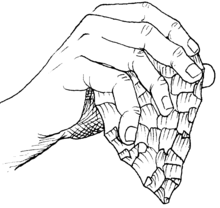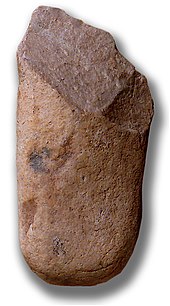Stone appliance
As stone tools , stone tools or stone artifact in to archeology all of people or their hominid ancestors artificially modified stones called. Because of their relative resistance to weathering in the soil, stone products (stone artifacts) are essential archaeological sources for evidence of the earliest human activities. In the course of human tribal history , the appearance of the devices has been refined and the manufacturing techniques have become more complex.
The analysis of stone artifacts is part of prehistoric archeology . The most frequently used material of the European Paleolithic was the flint (flint nodules from chalk formations , chert ), in addition, silica slate , quartzite and rhyolite as well as pure, macrocrystalline quartz were used. Since the first nomenclature created by Gabriel de Mortillet in 1869, stone appliance traditions have formed the basis for classifying older prehistory . Archaeological cultures defined by stone tools include the Paleolithic and Mesolithic in Europe, and the Early Stone Age , Middle Stone Age and Later Stone Age in Africa . The function of stone tools and thus the economy of their users can also be partially deduced from the shape and method of manufacture.
Definition of terms
In archaeological parlance, a distinction is made between two levels: stone implements , stone tools and stone artefacts are used synonymously as compound terms, here they stand as a generic term for all stones that have been modified by humans and used as tools . In contrast, there is the term device or tool in the terminology of stone artifacts (especially from flint ). Here the device or tool stands for retouched basic shapes and thus in contrast to the unmodified basic shapes of tee and core .
Stone tools of the Paleolithic

During the Early Stone Age , the beginning of which is linked to the oldest evidence of stone utensils in Africa, slightly processed, rounded river pebbles were used as raw material for the manufacture of simple tools; these early stone implements are known as rubble implements . The oldest rubble tools (= stone tools of the Oldowan ) that are considered to be secure come from the Gona site near Hadar in Ethiopia . They are 2.6 to 2.5 million years old. Finds from the archaeological site Bokol Dora 1 (BD 1) in the Afar region in north-eastern Ethiopia are similarly old . With an age of 2.34 million years, stone tool finds from the western shore of Lake Turkana in Kenya are almost the same age.
In the area of the Bouri site near Gona , 2.5 million year old fossil bones have been discovered that show the cut marks of stone tools.
Parallel notches in two wild animal bones from the Ethiopian site of Dikika , south of Hadar, are around 800,000 years older and were also interpreted as cutting marks from stone tools. The age of these fossils has been dated from 3.42 to 3.24 million years using the 39 Ar- 40 Ar method . From this period only Australopithecus afarensis finds are known, including the best preserved fossil of Australopithecus afarensis , whose scientific name is DIK 1-1 ; its age has also been dated approximately 3.3 million years ago. However, the interpretation of these notches is controversial. Stone tools or cuts from the manufacture of stone utensils have never been found in the layers of the Australopithecus afarensis found; However, numerous fossil remains of crocodiles were found at the place where the two wild animal bones were found, whose bite marks can cause damage to bones very similar to that of stone tools.
- Basics of the history of the development of stone tools
They also name the most important periods:
- Oldowan (only in Africa): Pebble tools , probably made by Homo rudolfensis , Homo habilis and Homo ergaster / Homo erectus .
- Acheuléen (Africa, Asia, Europe): Hand axes , probably made by Homo habilis , Homo rudolfensis and Homo ergaster / Homo erectus
- Middle Paleolithic (Europe): characteristic is the Levallois technique , the characteristic core mining technique of the Neanderthals , which first appeared about 300,000 years ago .
- Middle Stone Age (Africa): Beginning of blade techniques in South Africa about 65,000 years ago (see Howieson's Poort Industry )
- Upper Paleolithic : new "blade technology" with conical blade cores; occurs as a technique of anatomically modern humans ( Homo sapiens ) around 40,000 years ago in Europe
Stone tools of the Neolithic Age
A major breakthrough in technology is the transition from stone tools (e.g. hand ax ) to finally ground stone tools ( stone axes ). Cut stone was defined by John Lubbock in 1865 as the most important feature of the Neolithic (Neolithic).
Stone tools during the metal times
Stone tools remained in use during the Bronze Age and Iron Age in Europe, for example in the form of arrowheads or lighters (made of flint and pebbles ).
Younger story
Stone tools are still important regionally today, for example in the form of grinding equipment ( grinding stone , mortar ) or in metal processing. In "cold forging" in West Africa stone balls and stone hammers are used to work metal.
See also
Web links
- Press release of the Max Planck Society of August 11, 2010: "Lucy's conspecifics used tools and ate meat"
- nytimes.com of August 11, 2010: "Lucy's Kin Carved Up a Meaty Meal, Scientists Say" (with a picture of the cut marks from Dikika )
Individual evidence
- ↑ Joachim Hahn : Recognizing and determining stone and bone artifacts. Introduction to artifact morphology. Archaeologica Venatoria 10, 1991
- ↑ Gabriel de Mortillet: Essai d'une classification des cavernes et des stations sous abri fondée surles produits de l'industrie humaine . In: Materiaux pour l'histoire de l'Homme. Volume 5, Paris 1869, pp. 172-179.
- ↑ Sileshi Semaw et al .: 2.5-million-year-old stone tools from Gona, Ethiopia. In: Nature . Volume 385, 1997, pp. 333-336, doi: 10.1038 / 385333a0
-
↑ David R. Braun, Vera Aldeias, Will Archer et al .: Earliest known Oldowan artifacts at> 2.58 Ma from Ledi-Geraru, Ethiopia, highlight early technological diversity. In: PNAS . Volume 116, No. 24, 2019, pp. 11712–11717, doi: 10.1073 / pnas.1820177116
Human ancestors invented stone tools several times. On: mpg.de from June 3, 2019 - ↑ Hélène Roche et al .: Early hominid stone tool production and technical skill 2.34 Myr ago in West Turkana, Kenya. In: Nature. Volume 399, 1999, pp. 57-60, doi: 10.1038 / 19959
- ↑ Jean de Heinzelin, J. Desmond Clark, Tim White et al .: Environment and Behavior of 2.5-Million-Year-Old Bouri Hominids. In: Science . Volume 284, No. 5414, 1999, pp. 625-629, doi: 10.1126 / science.284.5414.625
- ↑ Shannon P. McPherron et al .: Evidence for stone-tool-assisted consumption of animal tissues before 3.39 million years ago at Dikika. In: Nature. Volume 466, 2010, pp. 857-860, doi: 10.1038 / nature09248
- ↑ Manuel Domínguez-Rodrigo et al .: Configurational approach to identifying the earliest hominin butchers. In: PNAS. Volume 107, No. 49, 2010, pp. 20929-20934, doi: 10.1073 / pnas.1013711107
- ^ John Lubbock: Prehistoric Times, as Illustrated by Ancient Remains and the Manners and Customs of Modern Savages. Williams and Norgate, London 1865 (German edition: The prehistoric times explained by the remains of antiquity and the manners and customs of today's savages. Costenoble, Jena 1874, 2 volumes)


